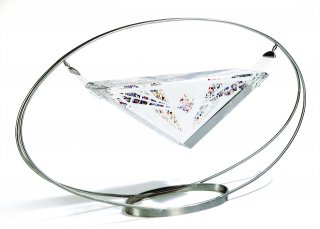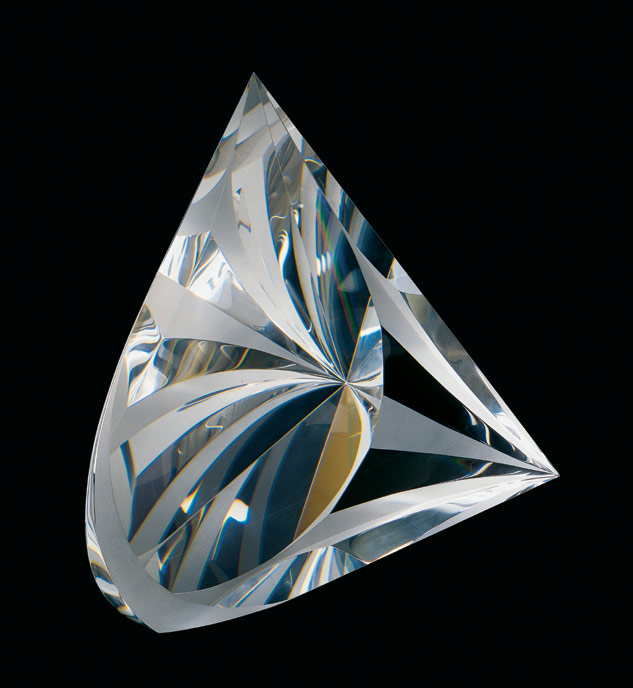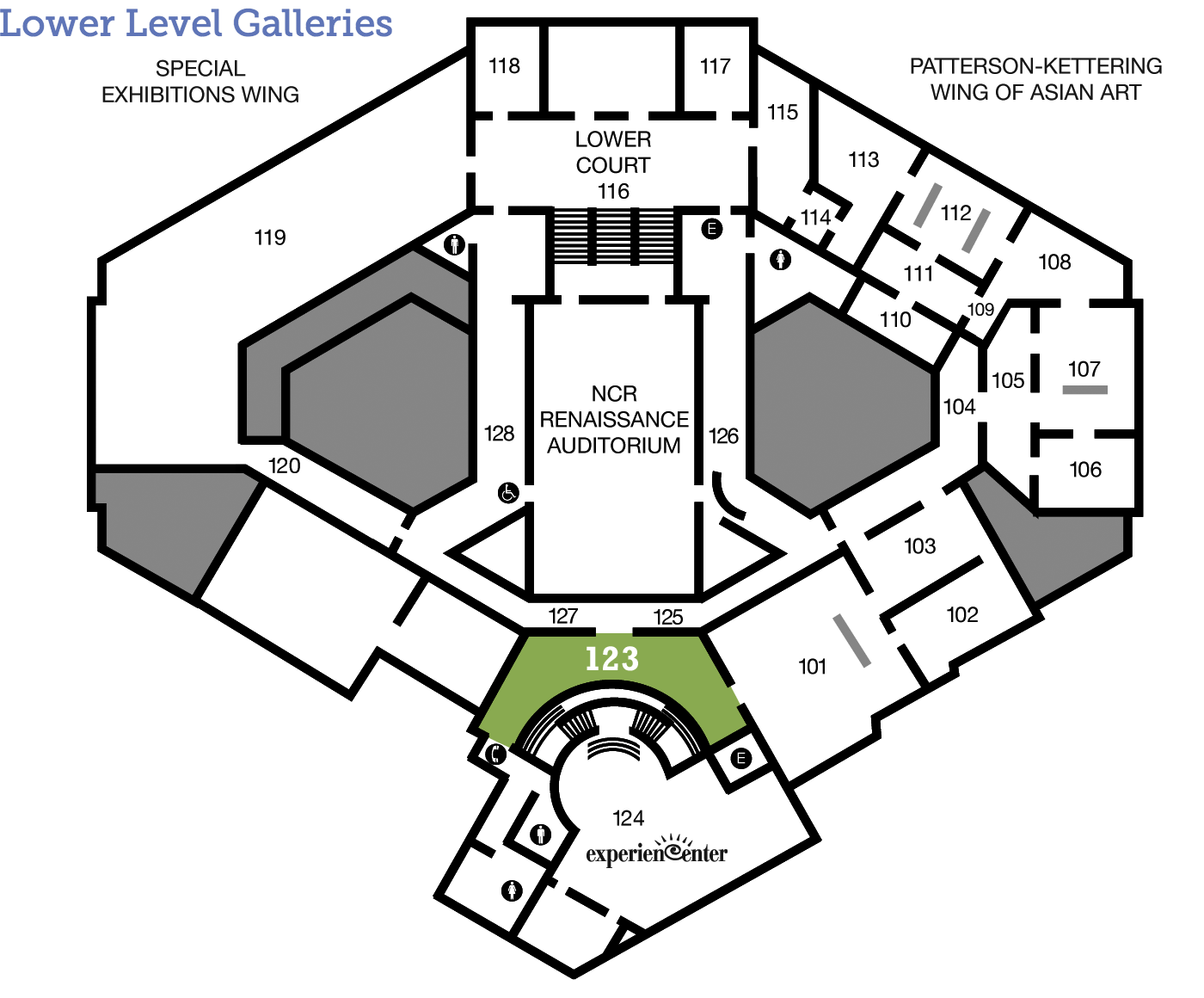
Jon Kuhn
Bold Endeavor
(b.1949)
American 1998 laminated, cut, and polished glass 9½ x 24 x 6 in. (glass), 24½ x 45¾ x 8½ (base) Museum purchase with funds from the James F. Dicke Family 1999.29
Into the Light
Purity; precision; perfection. This is the vocabulary of glass sculptor Jon Kuhn and his team of workers. Together they take some of the purest glass and craft it with precision tools to produce perfect sculptures that fuse the scientific with the artistic, the physical with the spiritual.
A Day in the Life
Tools and Techniques
Save the Heat for the Kitchen!
Jon Kuhn is one of the few glass artists who works in cold glass. This requires very different techniques than typical art glass, which is most often made by manipulating glass with heat. Using a variety of industrial tools and a team of over twenty-seven workers, Kuhn cuts, laminates, and polishes glass into an infinity of shapes that reflects out to viewers and pulls them back in. Learn more about some of the tools and techniques of cold glass grinding and polishing in this video from the Corning Museum of Glass.
Used with the permission of The Corning Museum of Glass
Transcript:
“Most of the glass we’ve been looking at was formed and decorated while the glass was hot and soft. But very often, glass is finished—sometimes decorated—while it is cold, by a variety of mechanical techniques.
A variety of machines and tools can be used to grind glass. This is a flat mill. It’s a rotating wheel made of steel. And its surface is being fed continuously with a grit—carborundum grit. The work is pushed back and forth to keep from wearing away one spot in the wheel. A similar process can be done by hand using a sheet of glass as the surface. This is often called ‘hand finishing.’
Surfaces covered with industrial diamonds can be used in place of the flat, rotating metal with the grit. This is a coarse diamond. When work is pressed against it, it rapidly removes glass. The surface left behind is very rough. A somewhat finer grit of diamond can be used to smooth the surface and leave the surface less matte. Next, a very fine grit diamond is used to nearly produce a polished surface. The surface is still slightly matte.
The final step in the natural sequence of grinding and polishing is to use the material cerium oxide held against a rotating wheel, to give the glass its original, pristine sheen. Because the cerium oxide is of such fine porosity, it takes considerably longer time to polish the glass than to grind it.
Belt sanders not unlike those used for finishing wood can be outfitted with special belts for cutting glass. The procedure is identical to that used with the wheels. This is commonly used today for finishing the edges of sheet glass.”
Behind the Scenes
Look Closer
Clear as Crystal?
The glass Jon Kuhn uses for this transparent sculpture is not your grandmother’s opaque milk glass! Kuhn uses ultra-pure crystal glass from Schott Glass Technologies Inc., whose headquarters is in Elmsford, New York. Schott develops glass for defense, optics, and aviation, among other applications. The glass can be up to 99.8% transparent. Your average window glass, by comparison, is only about 70% transparent. Can you see the lines where the pieces of glass were laminated together?
And what about the colored square in the middle? Jon Kuhn calls this “core material.” It is made by gluing a sheet of clear glass to colored glass made by Bullseye, an art glass manufacturer in Portland, Oregon. This sheet is then ground into a thin plane, cut into fine strips, which are then layered perpendicularly and laminated, and cut and shuffled further until the result is a grouping of brilliant colors. No two pieces are alike and once created they appear to change color when viewed from different angles and in different lighting.
Additional Information: See James Yood, “Into the Light—The Art of Jon Kuhn,” in Spectrum: The Sculpture of Jon Kuhn, edited by Melissa G. Post, (Charlotte, N.C.: The Mint Museums, 2003), 38.
Just for Kids
Try it!
Look at Jon Kuhn’s Bold Endeavor. What do you notice? What shapes is the artist using? Do the shapes look flat or 3-D? Why? Jon Kuhn used one-point perspective. Perspective allows us to see depth in a work of art. Shapes in the foreground look larger than the small objects in the background. Can you find any other works in the museum that show perspective?
To create your own one-point perspective art grab a ruler, pencil, and drawing paper. Begin by drawing a straight line in the middle of your paper. This will be the horizon line. At the middle of the horizon line make a dot. This dot will be the vanishing point. Then, make an “x” from corner to corner passing the center through the dot.
Draw a shape like a rectangle or square. Connect each point of the shape to the middle dot. Use the ruler to make a straight line from the square to the dot. If there are four points in a square, there will be four lines at the dot. Make parallel lines to the original shape to finish. Erase the lines that you do not need.
Signs & Symbols
Dig Deeper
Seeing the Spiritual
While Jon Kuhn’s sculptures have a mathematical logic to them, they also shimmer with a spiritual light. Indeed, the pursuit of the spiritual has guided the evolution of his work. This is summarized in the following quote by Kuhn.
Throughout my artistic career, my work has been reflective of my own evolving philosophy; influenced substantially by eastern mysticism. The mystics tell us that through meditation we find the ‘universe within.’ The ability of glass to visually contain pertinent or critical information beneath the surface makes it the ideal medium to express this concept. By looking inside, we get a different view or understanding of the exterior.
Additional Information: Quoted in Jon Kuhn: Retrospective, edited by Robert T. Soppelsa, (Topeka, Kansas: Mulvane Art Museum, 1998), 2.
Arts Intersected
The Sculpture Speaks
Did You Know?
Expert Opinion
Look Around
Cold Glass Competition!
If you’re standing in the galleries, look at Christopher Ries’s Celebration. Both Jon Kuhn and Christopher Ries utilize glass manufactured by Schott, and both work in cold process, cutting, grinding, and polishing until they get just the surface and shape they want. However, Ries works with one solid piece of glass while Kuhn slices and dices and reassembles. What do you think of the final results?

Christopher Ries (b.1952),
Celebration, 1998,
cut and polished glass. Museum purchase with funds provided by the James F. Dicke Family,
1999.31.
Looking at these sculptures, how do the unique properties of glass as an art medium—how it can be manipulated to reflect, refract, and absorb light—cause you to experience light differently compared with other fine art mediums such as paint or stone?
About the Artist
Talk Back
Are You Enlightened?
Bold Endeavor accents light, how it reflects and refracts, shines and sparkles. How does light, either as a physical property or an abstract concept, relate to what makes something a masterpiece? Can anything completely dark be a masterpiece?

